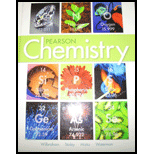
Chemistry 2012 Student Edition (hard Cover) Grade 11
12th Edition
ISBN: 9780132525763
Author: Prentice Hall
Publisher: Prentice Hall
expand_more
expand_more
format_list_bulleted
Question
Chapter 23.4, Problem 31LC
Interpretation Introduction
Interpretation : To state the names and uses of three
Concept Introduction : Polymers are formed when monomers combine. Polymers play an important role in the daily routine. Some items that are used in the kitchen such as steel are polymer. Bricks that are used in the construction of the house are a polymer.
Expert Solution & Answer
Answer to Problem 31LC
Three polymers that are used in homes everyday:
- Steel
- Bricks
- Glass
Explanation of Solution
- Steel is used in our daily homes for various uses such as making pots that are used for carrying water, utensils to store things, and also pans that are used in cooking.
- Bricks: Bricks are used in daily lives to build houses, boundary walls, and also
- Glass: Glass is used to make windows, car windows, drinking glasses, and more.
Conclusion
Many polymers are useful in our daily lives. Three common polymers found in our daily lives are steel, bricks, and glass which have many uses.
Chapter 23 Solutions
Chemistry 2012 Student Edition (hard Cover) Grade 11
Ch. 23.1 - Prob. 1LCCh. 23.1 - Prob. 2LCCh. 23.1 - Prob. 3LCCh. 23.1 - Prob. 4LCCh. 23.1 - Prob. 5LCCh. 23.1 - Prob. 6LCCh. 23.1 - Prob. 7LCCh. 23.1 - Prob. 8LCCh. 23.2 - Prob. 9LCCh. 23.2 - Prob. 10LC
Ch. 23.2 - Prob. 11LCCh. 23.2 - Prob. 12LCCh. 23.2 - Prob. 13LCCh. 23.2 - Prob. 14LCCh. 23.2 - Prob. 15LCCh. 23.3 - Prob. 16LCCh. 23.3 - Prob. 17LCCh. 23.3 - Prob. 18LCCh. 23.3 - Prob. 19LCCh. 23.3 - Prob. 20LCCh. 23.3 - Prob. 21LCCh. 23.3 - Prob. 22LCCh. 23.3 - Prob. 23LCCh. 23.4 - Prob. 24LCCh. 23.4 - Prob. 25LCCh. 23.4 - Prob. 26LCCh. 23.4 - Prob. 27LCCh. 23.4 - Prob. 28LCCh. 23.4 - Prob. 29LCCh. 23.4 - Prob. 30LCCh. 23.4 - Prob. 31LCCh. 23 - Prob. 32ACh. 23 - Prob. 33ACh. 23 - Prob. 34ACh. 23 - Prob. 35ACh. 23 - Prob. 36ACh. 23 - Prob. 37ACh. 23 - Prob. 38ACh. 23 - Prob. 39ACh. 23 - Prob. 40ACh. 23 - Prob. 41ACh. 23 - Prob. 42ACh. 23 - Prob. 43ACh. 23 - Prob. 44ACh. 23 - Prob. 45ACh. 23 - Prob. 46ACh. 23 - Prob. 47ACh. 23 - Prob. 48ACh. 23 - Prob. 49ACh. 23 - Prob. 50ACh. 23 - Prob. 51ACh. 23 - Prob. 52ACh. 23 - Prob. 53ACh. 23 - Prob. 54ACh. 23 - Prob. 55ACh. 23 - Prob. 56ACh. 23 - Prob. 57ACh. 23 - Prob. 58ACh. 23 - Prob. 59ACh. 23 - Prob. 60ACh. 23 - Prob. 61ACh. 23 - Prob. 62ACh. 23 - Prob. 63ACh. 23 - Prob. 64ACh. 23 - Prob. 65ACh. 23 - Prob. 66ACh. 23 - Prob. 67ACh. 23 - Prob. 68ACh. 23 - Prob. 69ACh. 23 - Prob. 70ACh. 23 - Prob. 71ACh. 23 - Prob. 72ACh. 23 - Prob. 73ACh. 23 - Prob. 74ACh. 23 - Prob. 75ACh. 23 - Prob. 76ACh. 23 - Prob. 77ACh. 23 - Prob. 78ACh. 23 - Prob. 79ACh. 23 - Prob. 80ACh. 23 - Prob. 81ACh. 23 - Prob. 82ACh. 23 - Prob. 83ACh. 23 - Prob. 84ACh. 23 - Prob. 85ACh. 23 - Prob. 86ACh. 23 - Prob. 87ACh. 23 - Prob. 88ACh. 23 - Prob. 89ACh. 23 - Prob. 90ACh. 23 - Prob. 91ACh. 23 - Prob. 92ACh. 23 - Prob. 93ACh. 23 - Prob. 94ACh. 23 - Prob. 95ACh. 23 - Prob. 1STPCh. 23 - Prob. 2STPCh. 23 - Prob. 3STPCh. 23 - Prob. 4STPCh. 23 - Prob. 5STPCh. 23 - Prob. 6STPCh. 23 - Prob. 7STPCh. 23 - Prob. 8STPCh. 23 - Prob. 9STPCh. 23 - Prob. 10STPCh. 23 - Prob. 11STPCh. 23 - Prob. 12STPCh. 23 - Prob. 13STPCh. 23 - Prob. 14STPCh. 23 - Prob. 15STPCh. 23 - Prob. 16STPCh. 23 - Prob. 17STP
Knowledge Booster
Similar questions
- Answer the followings (Four): 1-What is the difference(s) between FOUR: a. Glyceride and phosphoglyceride. b. Wax and fat. c. Soap and fatty acid. d. HDL and LDL cholesterol e. Phospho lipids and sphingosine. 2-What are the types of lipids? 3-What are the main lipid components of membrane structures? 4-How could lipids play important rules as signaling molecules and building units? 5. The Structure variety of Lipids makes them to play significant rules in our body. Conclude briefly on this statement.arrow_forwardHO IV но. = HO но. HO. HO но. зад надо What is the product of the following reaction?arrow_forwardDraw the mechanism to make the alcohol 2-hexanol.arrow_forward
arrow_back_ios
SEE MORE QUESTIONS
arrow_forward_ios
Recommended textbooks for you
 ChemistryChemistryISBN:9781305957404Author:Steven S. Zumdahl, Susan A. Zumdahl, Donald J. DeCostePublisher:Cengage Learning
ChemistryChemistryISBN:9781305957404Author:Steven S. Zumdahl, Susan A. Zumdahl, Donald J. DeCostePublisher:Cengage Learning ChemistryChemistryISBN:9781259911156Author:Raymond Chang Dr., Jason Overby ProfessorPublisher:McGraw-Hill Education
ChemistryChemistryISBN:9781259911156Author:Raymond Chang Dr., Jason Overby ProfessorPublisher:McGraw-Hill Education Principles of Instrumental AnalysisChemistryISBN:9781305577213Author:Douglas A. Skoog, F. James Holler, Stanley R. CrouchPublisher:Cengage Learning
Principles of Instrumental AnalysisChemistryISBN:9781305577213Author:Douglas A. Skoog, F. James Holler, Stanley R. CrouchPublisher:Cengage Learning Organic ChemistryChemistryISBN:9780078021558Author:Janice Gorzynski Smith Dr.Publisher:McGraw-Hill Education
Organic ChemistryChemistryISBN:9780078021558Author:Janice Gorzynski Smith Dr.Publisher:McGraw-Hill Education Chemistry: Principles and ReactionsChemistryISBN:9781305079373Author:William L. Masterton, Cecile N. HurleyPublisher:Cengage Learning
Chemistry: Principles and ReactionsChemistryISBN:9781305079373Author:William L. Masterton, Cecile N. HurleyPublisher:Cengage Learning Elementary Principles of Chemical Processes, Bind...ChemistryISBN:9781118431221Author:Richard M. Felder, Ronald W. Rousseau, Lisa G. BullardPublisher:WILEY
Elementary Principles of Chemical Processes, Bind...ChemistryISBN:9781118431221Author:Richard M. Felder, Ronald W. Rousseau, Lisa G. BullardPublisher:WILEY

Chemistry
Chemistry
ISBN:9781305957404
Author:Steven S. Zumdahl, Susan A. Zumdahl, Donald J. DeCoste
Publisher:Cengage Learning

Chemistry
Chemistry
ISBN:9781259911156
Author:Raymond Chang Dr., Jason Overby Professor
Publisher:McGraw-Hill Education

Principles of Instrumental Analysis
Chemistry
ISBN:9781305577213
Author:Douglas A. Skoog, F. James Holler, Stanley R. Crouch
Publisher:Cengage Learning

Organic Chemistry
Chemistry
ISBN:9780078021558
Author:Janice Gorzynski Smith Dr.
Publisher:McGraw-Hill Education

Chemistry: Principles and Reactions
Chemistry
ISBN:9781305079373
Author:William L. Masterton, Cecile N. Hurley
Publisher:Cengage Learning

Elementary Principles of Chemical Processes, Bind...
Chemistry
ISBN:9781118431221
Author:Richard M. Felder, Ronald W. Rousseau, Lisa G. Bullard
Publisher:WILEY